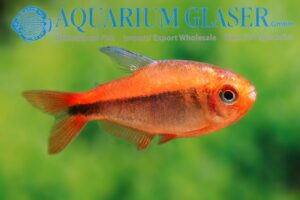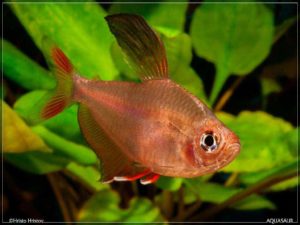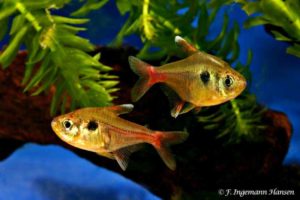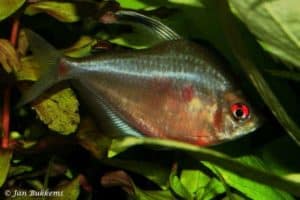Hyphessobrycon
Hyphessobrycon
Hyphessobrycon is a genus of small, colorful freshwater fish from South America. They are popular in aquariums because of their vibrant colors, peaceful behavior, and the fact that they like to swim in groups. Many well-known species, such as the lemon tetra and the fire tetra, belong to this genus. Hyphessobrycon species are suitable for both novice and experienced aquarium enthusiasts.
Name and meaning
The genus Hyphessobrycon was first scientifically described in 1882 by the Austrian ichthyologist Franz Steindachner.
The name “Hyphessobrycon” is composed of two parts, derived from Greek:
- ‘Hyphesson’ means “slightly smaller” or “subordinate.”
- “Brycon” is a reference to the genus Brycon, which also belongs to the characin family. The word ‘brycon’ comes from the Greek “bryko,” which means “to bite” or “to nibble.” This refers to the feeding behavior of these fish.
The name Hyphessobrycon therefore literally means “smaller biter” or “subordinate nibbler,” indicating that these fish are related to the genus Brycon but are smaller in size.
Hyphessobrycon belongs to the family Acestrorhamphidae (American Tetras).
Characteristics
Hyphessobrycon species are small, colorful freshwater fish that are very popular with aquarium enthusiasts. They have a number of distinct characteristics that make them so beloved:
Most species grow to between 3 and 6 centimeters in length, but there are also species that can grow slightly larger. They have a slender body that is slightly flattened at the sides. This allows them to move gracefully and easily through the water.
What really stands out about Hyphessobrycon is their beautiful color palette. Many species have bright colors such as red, yellow, orange, blue, or green. These colors are often combined with black spots, stripes, or a shiny line across their bodies. The fins are usually transparent, but can also be colored. In some species, the fins are even extra long or have striking colors, such as the pointed dorsal fin of the male Hyphessobrycon notidanos, which almost reaches the adipose fin, or the striking black and blue bands of the Hyphessobrycon cyanotaenia.
You can often see the difference between males and females. Males are usually slightly slimmer and, especially during the mating season, display even more intense colors than the females. If you take good care of these fish in an aquarium, they can usually live for 3 to 5 years.
Due to their modest size, beautiful colors, and peaceful nature, Hyphessobrycon species are perfect for a community aquarium.
Origin
The Hyphessobrycon species originate from the beautiful waters of Central and South America. They are widespread there and can be found in all kinds of rivers and streams.
Many different species live in the vast Amazon region in particular. Here, the water is often soft and slightly acidic, just as they like it. You will also find various Hyphessobrycon species in the basin of the Orinoco River, which flows through countries such as Venezuela and Colombia. Further south in South America, in the Paraná and Paraguay rivers (in countries such as Brazil, Paraguay, and Argentina), there are also many species to be found.
These fish prefer slow-flowing waters, such as small tributaries and streams. They like to seek shelter among dense vegetation, floating plants, roots, and leaves. In their natural environment, they usually live in large groups, also known as schools, and find safety among the plants and branches. The water in these areas is often clear, but can also be light brown due to the humic acids released from leaves and wood.
Behavior
Hyphessobrycon species are known for their peaceful and social behavior, which makes them excellent inhabitants for a community aquarium.
These fish feel most comfortable in a group. In nature, as well as in the aquarium, they form schools of conspecifics. It is therefore important to keep at least six to eight specimens. In such a school, they are less shy, feel safer, and their beautiful colors are much more striking. The iridescent lines on their bodies probably serve as visual signals, helping them to stay together in large schools, especially when they feel threatened. They usually swim loosely together, but move closer to each other when they sense danger.
In general, Hyphessobrycon species are friendly and can coexist well with other peaceful fish of similar size. They are active swimmers and you will often see them in the middle and upper layers of the aquarium. They are curious and always on the move.
Although they do not defend their territory, males may sometimes engage in short, harmless play fights, especially when they want to impress the females during mating season. When frightened or stressed, they quickly seek cover among the plants or other decorations in the aquarium.
Due to their social nature and lively behavior, Hyphessobrycon species are a beautiful and dynamic addition to a community aquarium.
Care requirements
Hyphessobrycon species are generally easy to care for, but to keep them healthy, active, and beautifully colored, it is important to meet a few basic needs.
Aquarium size: For a small school of six to eight Hyphessobrycon, a 60-centimeter aquarium with a minimum of 80 liters is usually suitable. If you want to keep a larger group or combine several species, a larger aquarium is always better. Some specific species, such as the Red Phantom Tetra (Hyphessobrycon sweglesi), feel more comfortable in an aquarium measuring 80 centimeters or more in length, which often means more than 80 liters of water.
Water values: These fish come from South America, where the water is often soft and slightly acidic. Try to replicate this in your aquarium:
- Temperature: Keep the temperature between 22 and 27°C. Some species, such as the Gold-shouldered Rosy Tetra (Hyphessobrycon paepkei) , can tolerate a slightly wider range of 22 to 28°C, and the Fire Tetra (Hyphessobrycon amandae) can even tolerate up to 29°C.
- pH value: A pH between 6.0 and 7.5 is ideal, i.e. slightly acidic to neutral water. For some species, such as the Red Phantom Tetra, the pH can even vary from 4.5 to 7.5, depending on their natural origin.
- Hardness: Soft to moderately hard water, with a hardness of 2 to 12 dGH, is best. For the Red Phantom Salmon, a hardness of GH 1 to 12 is suitable.
Filter and flow: A well-functioning filter is essential to keep the water clean. Also ensure a slight flow in the water, as this mimics their natural habitat.
Planting and decoration: Hyphessobrycon species feel safe and comfortable in a densely planted aquarium. Plenty of plants, floating plants, and hiding places (such as wood or stones) are important. Make sure there is also enough open swimming space, especially in the middle and upper layers of the aquarium. A dark substrate, for example sand or dark gravel, can bring out the colors of the fish. Adding oak or beech leaves can help to make the water slightly more acidic and brown, which mimics their natural habitat.
Lighting: Moderate to normal lighting is usually sufficient. Too bright light can make these fish shy, causing them to hide more.
Feeding: Hyphessobrycon are omnivores. Feed them a varied diet to keep them healthy and colorful. This can consist of:
- High-quality dry food, such as flake food, micro pellets, or granules.
- Frozen food, such as artemia, daphnia (water fleas), or mosquito larvae. Make sure the food is offered in small pieces to suit their small mouths.
- Live food, such as fruit fly larvae, micro worms, artemia, or water fleas, is a valuable addition and stimulates their natural hunting instinct.
- Also provide some plant material, which can be included in the flake food or in the form of spirulina flakes. If they do not get enough green food, they may nibble on soft aquarium plants. A piece of cucumber can prevent this, but remove it from the aquarium after an hour to prevent water pollution.
Feed in small portions so that it is eaten within a few minutes. Avoid overfeeding, as this can deteriorate the water quality.
Water change: Change 20-30% of the aquarium water weekly. This helps to keep the water quality stable and good.
By following these guidelines, your Hyphessobrycon fish will remain healthy and active and display their most beautiful colors.
Reproduction
It is quite possible to breed Hyphessobrycon species in the aquarium, especially if you replicate the conditions of their natural habitat as closely as possible.
Egg layers: Hyphessobrycon fish are egg layers. They usually scatter their eggs among fine-leaved plants, mosses, or floating plants. The eggs are often small and transparent.
Breeding aquarium: For best results, it is advisable to use a separate breeding aquarium.
- An aquarium of approximately 20 to 40 liters is often sufficient. For the Red Rio (Hyphessobrycon flammeus), for example, a 75-liter aquarium with approximately 45 liters of osmosis water (R/O water) is used.
- Ensure soft, slightly acidic water (e.g., pH 6.0-6.5) and a temperature of 24-26°C. For the Red Rio, a temperature of approximately 24.5°C worked well. For the Colombian Tetra (Hyphessobrycon columbianus), a temperature of approximately 28°C and a pH of 6 are considered ideal for reproduction.
- Use a sponge filter for gentle filtration and lots of fine-leaved plants or special mops on the bottom. This gives the fish places to lay their eggs and helps prevent the parents from eating them.
- Dim the lighting in the breeding aquarium. For the Red Rio, the lighting was even moved and tilted to provide as little light as possible.
Conditioning the parent fish: Before placing the fish in the breeding aquarium, it is important to feed them well. Feed the males and females plenty of live or frozen food for a week, such as brine shrimp, daphnia, chopped earthworms, or finely chopped shrimp. This will get them in top condition and stimulate egg production in the females. It may also help to keep the males and females separate for a while before bringing them together in the breeding aquarium.
Egg laying: Once the females are full of eggs, you can add the males to the breeding aquarium. Egg laying usually takes place in the early morning. The females lay their eggs, which are immediately fertilized by the males.
Removing the parents: After the eggs have been laid, it is crucial to remove the parent fish from the breeding tank. They may eat their own eggs or the newly hatched fry.
Rearing the fry:
- The eggs hatch after about 24 to 36 hours. For the Red Rio, the estimated incubation time is about three days.
- After removing the parents and depositing the eggs, it is a good idea to darken the breeding aquarium, for example by turning off the lights and covering it with a blanket. Some young tetras are sensitive to light.
- The young fish, also known as ‘wigglers’, often appear within a few hours after the parents have been removed.
- After a few days, the young can be fed with very small food, such as infusoria, liquid rearing food, micro worms, or paramecium.
- Once they are a little bigger, you can switch to artemia nauplii (newly hatched artemia) or baby brine shrimp.
- After a few days, you can also start gradually changing the water, for example by replacing half of the osmosis water with aged tap water.
With patience and the right preparation, you can raise young Hyphessobrycon yourself.
Compatibility
Hyphessobrycon species are ideal companion fish due to their peaceful and social nature. However, it is important to think carefully about which tank mates you choose, so that everyone in the aquarium feels comfortable.
With other Hyphessobrycon species: These fish feel most comfortable in a group. They are true schooling fish and it is advisable to keep at least six to eight of them. In a school, they are less shy, feel safer, and display their natural behavior and most beautiful colors.
With other fish: In general, Hyphessobrycon species are friendly and can coexist well with other calm, non-aggressive fish of similar size. These include other small tetra species, small Corydoras species (armored catfish), Nannostomus (pencil fish), small gouramis, and dwarf catfish. It is always wise to thoroughly research the specific needs and temperament of the fish you want to combine beforehand.
Avoid large or aggressive fish: It is important to avoid large predatory fish or aggressive species. These can chase Hyphessobrycon fish, cause them stress, or even see them as food. Therefore, always choose peaceful tank mates that are not too large.
With shrimp and small invertebrates: In a well-planted aquarium, Hyphessobrycon species can often live together with larger shrimp. However, very small shrimp or young shrimp can sometimes be seen as a tasty snack. So be careful with this.
With plants: Good news for plant lovers: Hyphessobrycon species leave aquarium plants alone. They are therefore ideal for densely planted aquariums, where they also find plenty of hiding places.
Due to their friendly nature, Hyphessobrycon species are an excellent choice for a community aquarium with other peaceful fish.
Suitable aquariums
Hyphessobrycon species are versatile fish that thrive in various types of aquariums. Their needs are relatively simple, making them a good choice for a variety of setups.
Community aquarium: They are ideal for a community aquarium, together with other small, peaceful fish. Their social behavior and beautiful colors bring a lot of life and movement to the aquarium. They like to swim in schools, which adds a dynamic effect to the setup.
Planted aquarium: An aquarium with lots of plants, floating plants, and hiding places mimics their natural habitat and makes them feel safe. Floating plants, for example, are highly appreciated by the Lemon tetra (Hyphessobrycon pulchripinnis). Make sure there is enough open swimming space in the middle and upper layers of the aquarium, as they are active swimmers.
Biotoop aquarium: Enthusiasts may enjoy creating a South American biotoop aquarium. This means a setup that resembles their natural habitat as closely as possible. Think soft, slightly acidic water, lots of plants, some wood and leaves on the bottom. A dark substrate, such as sand or dark gravel, can bring out the colors of the fish.
Aquarium size: Although most Hyphessobrycon species remain small, an aquarium of at least 80 liters is generally suitable for a small school. However, bigger is always better, especially if you want to combine several species or keep a larger school. For the Lemon tetra, for example, a minimum length of 50 cm for the aquarium is recommended, which often means an aquarium of 60 liters or more. Smaller species such as the Fire tetra (Hyphessobrycon amandae) can be kept in aquariums from 50 liters, but here too, a larger tank is preferable for a more stable environment and more swimming space.
Setup: Ensure a good balance between dense planting at the edges and back wall, and open swimming space in the middle and top of the aquarium. This gives the fish both safety and the opportunity to swim freely.
With this setup, Hyphessobrycon species feel at their best and show their most beautiful behavior and colors.
Species in the database
Below you will find the species within this genus that we have included in our database:

Showing all 23 results
Showing all 23 results























